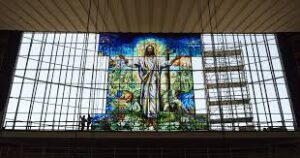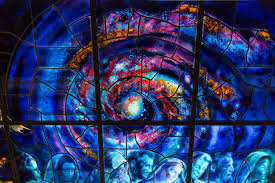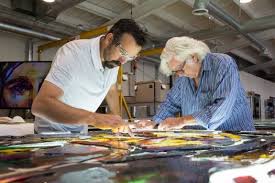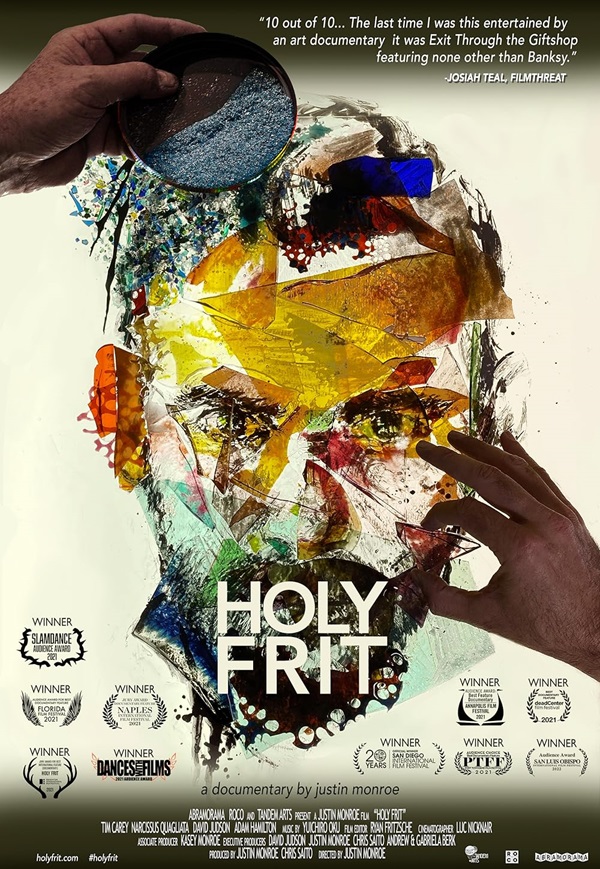By: Valerie Milano
Los Angeles, CA (The Hollywood Times) 6/28/24 – In the heart of Leawood, Kansas, the United Methodist Church of the Resurrection stands adorned with an awe-inspiring piece of art: the world’s largest stained-glass window. This monumental project, captured in the documentary “Holy Frit,” chronicles the journey of artist Tim Carey and Judson Studios as they strive to create this colossal masterpiece. The film not only documents the technical and creative challenges but also delves into the human dynamics and deeper universal themes that resonate with audiences far beyond the realm of stained-glass art.
How Did This Documentary Come to Be?
 The inception of “Holy Frit” is a story of serendipity. Filmmaker Justin Monroe, who happened to be the neighbor of lead artist Tim Carey, became involved in the project almost by chance. Monroe recounts how his family moved to South Pasadena, California, and rented a place next door to Carey. Over time, as neighbors do, they got to know each other, often sharing beers and stories in their front yards. During these casual conversations, Monroe discovered Carey’s profession as a stained-glass artist at Judson Studios, while Carey learned about Monroe’s filmmaking background.
The inception of “Holy Frit” is a story of serendipity. Filmmaker Justin Monroe, who happened to be the neighbor of lead artist Tim Carey, became involved in the project almost by chance. Monroe recounts how his family moved to South Pasadena, California, and rented a place next door to Carey. Over time, as neighbors do, they got to know each other, often sharing beers and stories in their front yards. During these casual conversations, Monroe discovered Carey’s profession as a stained-glass artist at Judson Studios, while Carey learned about Monroe’s filmmaking background.
One day, Carey mentioned that Judson Studios was bidding on a project to create the largest stained-glass window in the world for the United Methodist Church of the Resurrection. They needed a promotional video to stand out among 60 competing firms from around the world. Monroe agreed to help, and upon visiting Judson Studios, he was captivated by the studio’s historical charm and the ambitious nature of the project. As Monroe filmed the promo video, interviewing Carey, studio owner David Judson, and other artisans, he realized the potential for a compelling documentary.
 Carey’s proposed design was groundbreaking and technically challenging, requiring techniques that Judson Studios had never attempted. The project had to be completed within a strict three-year timeline, and the only person who could potentially help was the renowned Italian glass maestro Narcissus Quagliata. Sensing a remarkable story, Monroe convinced Carey and Judson to allow him to document the entire process from the initial bid to the final installation of the window costing approx. about $3.5 mil.
Carey’s proposed design was groundbreaking and technically challenging, requiring techniques that Judson Studios had never attempted. The project had to be completed within a strict three-year timeline, and the only person who could potentially help was the renowned Italian glass maestro Narcissus Quagliata. Sensing a remarkable story, Monroe convinced Carey and Judson to allow him to document the entire process from the initial bid to the final installation of the window costing approx. about $3.5 mil.
Who Would Want to Watch a Movie About Stained Glass?
Initially, Monroe had significant concerns about the audience appeal of a documentary centered on stained glass. He wondered who would be interested in watching a film about a church window being created. However, as he delved deeper into the project, he realized that the story was much more than just about glass. It was about human drama, the clash of personalities, and the incredible journey of the artists involved.
 Monroe was particularly drawn to the dynamic between the young, talented, and somewhat contrarian Carey and the seasoned, eccentric Quagliata. Their mentor-mentee relationship added a compelling layer to the narrative. Additionally, the film featured a diverse cast of characters from Judson Studios, Bullseye Glass, and the church, each contributing to the rich tapestry of the story.
Monroe was particularly drawn to the dynamic between the young, talented, and somewhat contrarian Carey and the seasoned, eccentric Quagliata. Their mentor-mentee relationship added a compelling layer to the narrative. Additionally, the film featured a diverse cast of characters from Judson Studios, Bullseye Glass, and the church, each contributing to the rich tapestry of the story.
To Monroe’s surprise, audiences were captivated by the film from the very start. “Holy Frit” received six audience awards and four jury awards for best documentary during its festival run, including the Audience Award at the 2021 Slamdance Film Festival. The film currently boasts a 100% rating on Rotten Tomatoes and a 9.1 out of 10 rating on IMDB. It was also voted the #3 best documentary of 2023 by Movieweb. The film’s success underscores its ability to transform a niche subject into a universal, engaging narrative.
How Long Did the Process Take?
 The making of “Holy Frit” was a lengthy and arduous process. Monroe began filming on November 11, 2014, and the project spanned over nine years. The actual filming took 3.5 years, followed by another 3.5 years of post-production. The film then spent nearly two years on the festival circuit and recently concluded a 40-city theatrical run.
The making of “Holy Frit” was a lengthy and arduous process. Monroe began filming on November 11, 2014, and the project spanned over nine years. The actual filming took 3.5 years, followed by another 3.5 years of post-production. The film then spent nearly two years on the festival circuit and recently concluded a 40-city theatrical run.
One of the biggest challenges was condensing over 1,150 hours of footage into a cohesive documentary just shy of two hours. Monroe and his editor faced the monumental task of sifting through countless hours of material to capture the essence of the story. Despite the challenges, the result is a film that encapsulates the highs and lows of the journey, the technical intricacies, and the emotional depth of the project.
What Does It All Mean?
Beyond the specifics of creating a stained-glass window, “Holy Frit” explores deeper, universal themes. Monroe believes the film is much more than just a documentary about a window; it’s a character-driven drama that resonates with anyone facing seemingly insurmountable challenges. The story of Carey, a young artist, collaborating with the legendary Quagliata, mirrors the struggles and triumphs that many people experience in their own lives.
 Whether pursuing a doctorate, building a house, or training for a marathon, viewers can relate to the stress, drive, and fear of attempting something that feels nearly unattainable. The film also touches on themes of faith, perseverance, and the human spirit, making it a relatable and inspiring story for a broad audience.
Whether pursuing a doctorate, building a house, or training for a marathon, viewers can relate to the stress, drive, and fear of attempting something that feels nearly unattainable. The film also touches on themes of faith, perseverance, and the human spirit, making it a relatable and inspiring story for a broad audience.
The Process of Being Embedded
Monroe’s approach to filmmaking was immersive and observational. He believed that to capture the true essence of the project, he needed to be fully embedded in the process. Monroe aimed to become like a piece of furniture in the lives of the artists and artisans, allowing them to be viewed as their most authentic selves. This approach enabled him to capture the real-time stresses, failures, and victories of the project, providing a raw and unfiltered view of the journey.
Follow-Up Questions
Tim Carey’s Artistic Journey
Question: Can you share more about your background as an artist and how you came to specialize in stained glass?
Tim Carey: I’ve always been drawn to large-scale art and public installations. Stained glass offered a unique way to combine color, light, and storytelling in a way that few other mediums can.
Technical Challenges
Question: What were some of the biggest technical challenges you faced during the creation of the window?
Tim Carey: The sheer scale of the project was daunting. We had to buy new equipment and even open a second studio to meet the demands. Working with fused glass, which requires high temperatures and precise timing, added another layer of complexity.
Collaboration with Narcissus Quagliata
Question: How did the collaboration with Narcissus Quagliata influence the project?
Tim Carey: Narcissus brought a level of expertise and a unique vision that was crucial to the project’s success. While we often had creative differences, his input was invaluable in pushing the boundaries of what could be achieved with stained glass.
Question: What does this stained-glass window represent culturally, socially, and religiously?
Tim Carey: The window is not just a piece of art; it’s a symbol of faith, perseverance, and collaboration. It tells a story that resonates with people from all walks of life, reflecting both the spiritual and communal aspects of the church and the broader community.
Through “Holy Frit,” audiences gain an intimate glimpse into the creation of a monumental piece of art that transcends its medium. The documentary captures the technical marvel, the human drama, and the universal themes that make the project not just a window, but a reflection of the human spirit’s boundless creativity and resilience.
The Creative and Technical Process
The creation of the world’s largest stained-glass window required not only artistic vision but also innovative technical methods. Tim Carey and his team at Judson Studios faced the daunting challenge of executing a design that was impossible to achieve with traditional stained-glass techniques. The window, measuring 37 feet tall and 93 feet wide, needed to be both structurally sound and visually stunning.
Tim Carey: We realized early on that traditional leaded stained glass wouldn’t work for a project of this scale and complexity. We decided to use fused glass, a technique that involves layering glass and firing it in a kiln to create vibrant colors and intricate designs. This method allowed us to achieve the depth and detail that the design demanded.
The process began with detailed sketches and digital renderings, followed by the creation of full-scale cartoons (drawings) of each section of the window. These cartoons served as blueprints for cutting and assembling glass pieces. The team then meticulously cut, painted, and fused the glass in large kilns, often working around the clock to meet the tight deadlines.
Tim Carey: We had to buy new kilns and expand our studio space to accommodate the size of the panels. Each piece had to fit perfectly, and any mistake could set us back weeks. It was a high-pressure environment, but also incredibly rewarding to see each section come together.
The Role of Narcissus Quagliata
The collaboration with Narcissus Quagliata, a master glass artist known for his innovative work, was pivotal to the project’s success. Quagliata’s expertise in fused glass and his unique artistic vision brought a new dimension to the project.
Tim Carey: Working with Narcissus was both challenging and inspiring. He pushed us to think outside the box and to experiment with new techniques. His experience and guidance were invaluable, especially when we faced technical hurdles.
Quagliata’s influence is evident in the window’s dynamic composition and vibrant colors. His approach to glass as a medium that interacts with light in unique ways helped transform Carey’s initial design into a living, breathing work of art.
Narcissus Quagliata: “Stained glass is not just about creating images; it’s about creating experiences with light. This project allowed us to explore the full potential of glass as an expressive medium.”
The Cultural, Social, and Religious Significance
The stained-glass window at the United Methodist Church of the Resurrection is more than just an artistic achievement; it holds profound cultural, social, and religious significance. The window, titled “The Resurrection Window,” depicts the story of Jesus Christ’s resurrection, symbolizing hope, renewal, and the triumph of light over darkness.
Tim Carey: This window is a visual sermon. It tells the story of faith and redemption in a way that words cannot. We wanted it to be a source of inspiration and reflection for everyone who sees it, regardless of their background or beliefs.
The window’s impact extends beyond the church congregation. It has become a landmark in the community, attracting visitors from around the world who come to marvel at its beauty and craftsmanship. The project has also sparked conversations about the role of art in sacred spaces and its ability to foster a sense of community and shared humanity.
David Judson (Owner of Judson Studios): Art has the power to bring people together and to elevate the human spirit. This project has been a testament to that power. It has been a privilege to be part of something that touches so many lives.
Reflecting on the Journey
As “Holy Frit” concludes, it leaves viewers with a sense of awe and appreciation for the dedication, creativity, and resilience that went into creating The Resurrection Window. The documentary not only captures the technical and artistic journey but also the personal growth and transformation of the individuals involved.
Justin Monroe: Looking back, this project has been a rollercoaster of emotions. There were moments of doubt and frustration, but also moments of joy and triumph. It has been an honor to document this journey and to share it with the world.
The film’s success and the window’s completion serve as a reminder of what can be achieved when talent, passion, and perseverance come together. The Resurrection Window stands as a testament to the power of art to inspire, heal, and connect us to something greater than ourselves.
Tim Carey: This project has been the highlight of my career. It has pushed me to my limits and beyond, and it has taught me so much about myself and the power of collaboration. I hope that the window continues to inspire and uplift people for generations to come.
The creation of the world’s largest stained-glass window for the United Methodist Church of the Resurrection is a story of artistic innovation, technical mastery, and human perseverance. Documented in the film “Holy Frit,” this journey showcases the transformative power of art and the universal themes of faith, hope, and resilience. Through the eyes of filmmaker Justin Monroe, viewers are invited to witness the intricate process and the personal stories behind this monumental project.
The Resurrection Window not only enhances the spiritual experience of churchgoers but also stands as a beacon of artistic achievement and a symbol of the enduring human spirit. As the light filters through the vibrant glass, casting a kaleidoscope of colors into the sacred space, it serves as a constant reminder of the beauty and complexity of creation, both in art and in life.
For more information on “Holy Frit” and to watch the documentary, visit holyfrit.com.





